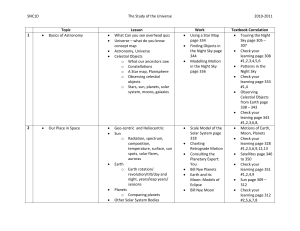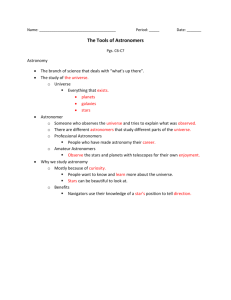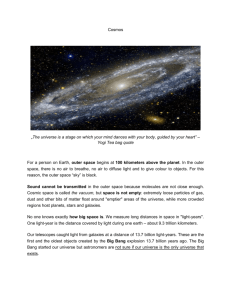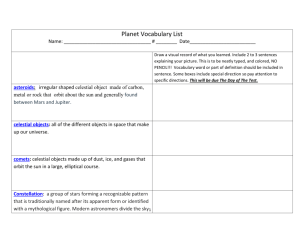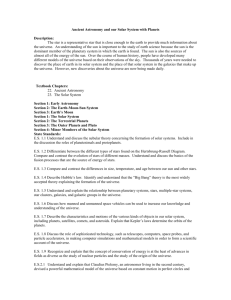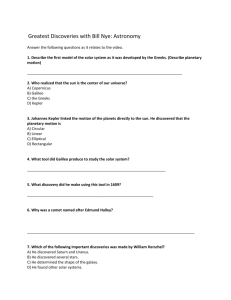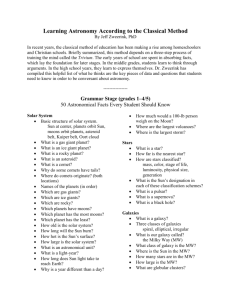Review All the Worksheets (ALL the calculations)
advertisement
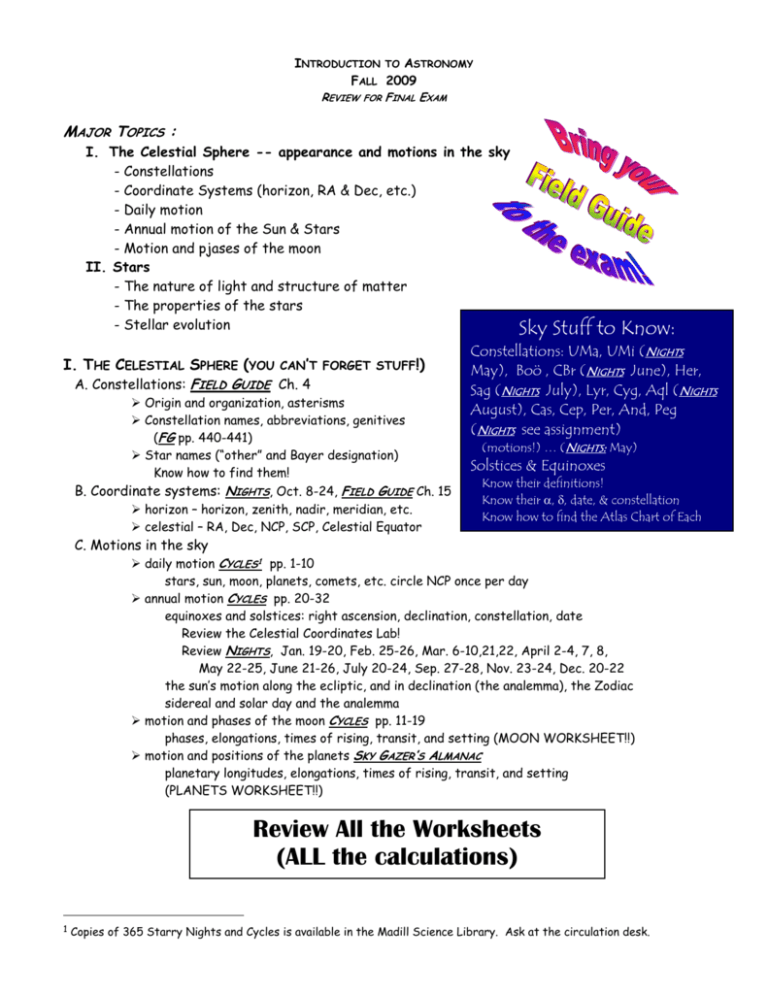
INTRODUCTION TO ASTRONOMY FALL 2009 REVIEW FOR FINAL EXAM MAJOR TOPICS : I. The Celestial Sphere -- appearance and motions in the sky - Constellations - Coordinate Systems (horizon, RA & Dec, etc.) - Daily motion - Annual motion of the Sun & Stars - Motion and pjases of the moon II. Stars - The nature of light and structure of matter - The properties of the stars - Stellar evolution I. THE CELESTIAL SPHERE (YOU CAN’T A. Constellations: FIELD GUIDE Ch. 4 FORGET STUFF!) ¾ Origin and organization, asterisms ¾ Constellation names, abbreviations, genitives (FG pp. 440-441) ¾ Star names (“other” and Bayer designation) Know how to find them! B. Coordinate systems: NIGHTS, Oct. 8-24, FIELD GUIDE Ch. 15 ¾ horizon – horizon, zenith, nadir, meridian, etc. ¾ celestial – RA, Dec, NCP, SCP, Celestial Equator Sky Stuff to Know: Constellations: UMa, UMi (NIGHTS May), Boö , CBr (NIGHTS June), Her, Sag (NIGHTS July), Lyr, Cyg, Aql (NIGHTS August), Cas, Cep, Per, And, Peg (NIGHTS see assignment) (motions!) … (NIGHTS: May) Solstices & Equinoxes Know their definitions! Know their α, δ, date, & constellation Know how to find the Atlas Chart of Each C. Motions in the sky ¾ daily motion CYCLES1 pp. 1-10 stars, sun, moon, planets, comets, etc. circle NCP once per day ¾ annual motion CYCLES pp. 20-32 equinoxes and solstices: right ascension, declination, constellation, date Review the Celestial Coordinates Lab! Review NIGHTS, Jan. 19-20, Feb. 25-26, Mar. 6-10,21,22, April 2-4, 7, 8, May 22-25, June 21-26, July 20-24, Sep. 27-28, Nov. 23-24, Dec. 20-22 the sun’s motion along the ecliptic, and in declination (the analemma), the Zodiac sidereal and solar day and the analemma ¾ motion and phases of the moon CYCLES pp. 11-19 phases, elongations, times of rising, transit, and setting (MOON WORKSHEET!!) ¾ motion and positions of the planets SKY GAZER’S ALMANAC planetary longitudes, elongations, times of rising, transit, and setting (PLANETS WORKSHEET!!) Review All the Worksheets (ALL the calculations) 1 Copies of 365 Starry Nights and Cycles is available in the Madill Science Library. Ask at the circulation desk. Phys102: Introduction to Astronomy Course Review II. STARS A. Spectroscopy ¾ The nature of light: c =λf, E = hf = [hc/λ] ¾ inverse square law: luminosity and flux ¾ inverse square law: luminosity and flux γ-rays X-rays Ultraviolet (UV) HIGH ENERGY HIGH FREQUENCY SHORT WAVELENGTH LOW FREQUENCY LONG WAVELENGTH blue green yellow orange red Visible Infrared (IR) Radio LOW ENERGY ¾ electromagnetic spectrum ¾ atomic structure, source of emission and absorption lines ¾ Hydrogen Balmer spectrum ¾ Spectral Classes: O B A F G K M order (A – N): Willamina Fleming order (O – M): Antonia Maury – plus Cepheid Variables! subclsses & classification: Annie Jump Cannon temperature association: Cecillia Payne Gaposchkin B. Star Properties (how do we measure or calculate … any needed equations will be given) ¾ ¾ ¾ ¾ temperature distance size flux and luminosity Review “Magnitudes, Luminosities and Sizes” worksheets C. HR diagram NIGHTS, March 15-21, FIELD GUIDE Appendix 3 ¾ axes (what’s plotted against what? What are the scales) ¾ regions (Main Sequence, Giants (red & blue) Dwarfs (red & white), Luminosity Classes) ¾ be able to plot positions of stars (given Mv and Spectral Type)! D. Stellar evolution (be able to explain each process and give examples of objects in each stage) ¾ Star Birth (e.g. Great Nebula in Orion, Eagle Nebula: Pillars of Creation ) ¾ Main Sequence Stars What process defines a STAR? E=mc What is a star’s source of energy? Sunspots & Solar Max Know name, ¾ Red Giant Stage position & what starts and ends this stage in constellation low-mass stars (Sol) of examples ¾ Star Death of each Planetary Nebula and White Dwarf stage Supernova and Neutron Stars Supernova and Black Hole 2 Page 2 Study the Astronomy Notes at http://www.astronomynotes.com/ Stellar Evolution http://zebu.uoregon.edu/~imamura/122/ astro.122.html Phys102: Introduction to Astronomy Course Review III. THE SOLAR SYSTEM - worlds (expect images … study the power points and your Field Guide Ch. 8 - 14) Be able to describe the basic nature (rocky, icy, gas, atmosphere, craters, volcanoes, etc.) of the inner eight planets, the Galilean Moons, Titan, Enceladus, Mimas, Miranda, Triton, and Luna. Also know where to find (as in, the world) the largest impact crater, largest volcano and largest mountain. - current positions of the planets in the sky (http://www.fourmilab.ch/solar/solar.html) understand how to use Appendix 11 and the planetary longitudes to find the positions of the planets (and the sun … and the moon using the phases listed on FG pp. 350-1) in the sky - arrangement, size, and formation of the solar system Handy Websites: http://www.seds.org/billa/tnp/ http://stardate.org/resources/ssguide/ http://www.novaspace.com/ The Astronomical Unit (AU) 1 AU = mean Earth-Sun distance = 150,000,000 km (150 million km) = 93,000,000 mi ( ≈ 100 million miles is close enough) See details on Solar System review sheet! NAME SYMBOL SIZE MERCURY ☿ 0.4 R⊕ VENUS ♀ EARTH DISTANCE FROM SOL E W LENGTH OF DAY LENGTH OF YEAR 0.4 AU 60 d⊕ ¼ y⊕ 0.95 R⊕ 0.7 AU 243 d⊕ (R) 0.6 y⊕ ⊕ 1.0 R⊕ 1.0 AU 1d⊕ 1 y⊕ MARS ♂ 0.5 R⊕ 1.5 AU 1.03 d⊕ 2 y⊕ JUPITER ♃ 11 R⊕ 5 AU 10 h⊕ SATURN ♄ 9.5 R⊕ 10 AU 10.25 h⊕ 30 y⊕ URANUS ♅ 4.1 R⊕ 20 AU 17 h⊕ (R) 85 y⊕ NEPTUNE ♆ 3.9 R⊕ 30 AU 16 h⊕ 165 y⊕ PLUTO ♇ 0.2 R⊕ 40 AU 6 d⊕ (R) 250 y⊕ 12 y⊕ (≈ ONE CONSTELLATION OF THE ZODIAC PER YEAR) - current positions of the planets in the sky (http://www.fourmilab.ch/solar/solar.html) understand how to use Appendix 11 and the planetary longitudes to find the positions of the planets (and the sun … and the moon using the phases listed on FG pp. 350-1) in the sky - Earth as a planet -- interior (http://pubs.usgs.gov/publications/text/dynamic.html) interior layers: names, composition, phase (solid, liquid, plastic) be able to explain the driving force of plate tectonics -- surface cratering, volcanism (http://volcano.oregonstate.edu/) plate tectonics (http://volcano.oregonstate.edu/education/vwlessons/lessons/lesson1.html) oceans: the importance of water in the evolution of the atmosphere & life -- atmosphere composition, evolution, circulation (Hadley Cells), weather Page 3 Phys102: Introduction to Astronomy Course Review IV. Galaxies and Cosmology - Types of galaxies (be able to recognize the ones on the Power Points!) - details about the Milky Way (dimensions, contents, interactions) - details about dark matter (why do we believe it’s there? what might it be?) - The DATA of Big Bang Cosmology all galaxies are redshifted ⇒ evidence that they are all moving away from us more distant galaxies are redshifted more ⇒ evidence that more distant galaxies are moving away faster ⇒ evidence that the universe is EXPANDING (Space, itself, is expanding!) the observed cosmic background radiation (CBR) fits the model of the coolest opaque universe (just before atoms formed and it became non-transparent) at a redshift appropriate to the time when the universe was last opaque. - The expansion of the universe ⇒ how is the universe like a raisin bread? ⇒ how is the universe like a gas? - The four fundamental forces and what they do NAME weakest GRAVITATIONAL FORCE WEAK NUCLEAR FORCE ELECTROMAGNETIC FORCE strongest STRONG NUCLEAR FORCE RELATIVE STRENGTH RANGE 1 ∞ 1025 10-17 m 1036 ∞ 1038 10-15 m PHENOMENON KEEPS US ON THE GROUND, MAKES STARS RESPONSIBLE FOR RADIOACTIVE DECAY MAKES CAT HAIR CLING TO ANYTHING HOLDS QUARKS & BARYONS TOGETHER IN SUSCEPTIBLE CARRIER PARTICLES PARTICLES all matter gravitons 10-43s nuclear particles weak bosons 10-10s charged matter photons 10-10s nuclear particles gluons 10-38s SEPARATION ABT - The history of the universe … after the moment of creation (t = 0 seconds) know what happened at about - 10-43 sec - 10-38 sec - 10-10 sec - 10-3 sec (1 millisecond) - 3 min - 500,000 years ∼1 Gy ∼13.6 Gy - Think about the origin of the protons, neutrons, and electrons in your body and the elements made from them in the cores and explosions of stars, and think about the Desiderata: Page 4 Phys102: Introduction to Astronomy Course Review Desiderata Go placidly amid the noise and haste, and remember what peace there may be in silence. As far as possible, without surrender, be on good terms with all persons. Speak your truth quietly and clearly, and listen to others, even the dull and ignorant; they too have their story. Avoid loud and aggressive persons; they are vexations to the spirit. If you compare yourself with others, you may become vain and bitter, for always there will be greater and lesser persons than yourself. Enjoy your achievements as well as your plans. Keep interested in your career, however humble; it is a real possession in the changing fortunes of time. Exercise caution in your business affairs; the world is full of trickery. But let this not blind you to what virtue there is: many persons strive for high ideals, and everywhere life is full of heroism. Be yourself. Especially do not feign affection. Neither be cynical about love, for in the face of all aridity and disenchantment it is perennial as the grass. Take kindly the counsel of the years, gracefully surrendering the things of youth. Nurture strength of spirit to shield you in sudden misfortune. But do not distress yourself with imaginings. Many fears are born of fatigue and loneliness. Beyond a wholesome discipline, be gentle with yourself. You are a child of the universe, no less than the trees and the stars; you have a right to be here. And whether or not it is clear to you, no doubt the universe is unfolding as it should. Therefore, be at peace with God, whatever you conceive God to be, and whatever your labors and aspirations, in the noisy confusion of life, keep peace with your soul. With all its sham, drudgery and broken dreams, it is still a beautiful world. Be careful. Strive to be happy. Max Erhmann, 1927. Page 5

